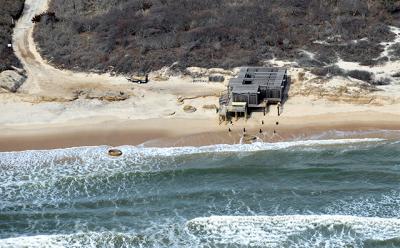Georgica Dunes Were ‘Ripped Apart’

The ocean dune near the Georgica Association’s bathhouse in Wainscott is gone, the East Hampton Town Trustees were told on Monday, and immediate action must be taken to save it.
The northeasters of Jan. 23 and Feb. 9 “really ripped the dune apart” at the 100-acre private enclave west of Georgica Pond, Billy Mack of First Coastal, a Westhampton Beach marine construction and environmental consulting firm, said Tuesday. He had told the trustees the night before that the storms had exposed the bathhouse’s septic system, along with drainage systems in its parking lot.
Mr. Mack sought permission from the trustees to transport 3,000 cubic yards of sand, dredged from Sagaponack Pond, down the beach to rebuild the dune, with the option to add up to 2,000 additional cubic yards. The required machinery would access the beach via Beach Lane in Wainscott. The project, he said, was particularly time-sensitive due to the approaching piping plover nesting season and the Easter holiday.
“We literally have to start this week,” Mr. Mack said of what he called an interim project. “We will need to bring in more as the beach recovers.” First Coastal restored the dune following Hurricane Sandy, he said, and a 10-year maintenance permit from the New York State Department of Environmental Conservation remains in place.
Jim Grimes, a trustee, said that while ocean water was rushing under the bathhouse after the storms, the structure itself, which Mr. Mack said was raised on pilings several years ago, “is not really in jeopardy at this point.” Mr. Grimes and Rick Drew, his colleague on the board, recently visited the site and “we both came to the conclusion that, maybe on an emergency basis, this needs to be addressed. But on a long-term basis, this bathhouse, the association may need to . . . I’m not going to say retreat, but I think some alternatives need to be explored,” referring to the septic system.
The septic system was shifted as far landward as possible when the bathhouse was raised, Mr. Mack replied. Mr. Grimes then suggested the association might obtain an easement from the adjacent property owner. “It’s a private owner,” Mr. Mack said, “but I am certainly willing to bring it up.”
“I feel we should give [a permit] to them right now,” Mr. Grimes told his fellow trustees, “but this is one of those things where I wouldn’t feel comfortable about issuing subsequent permits. We need to see a long-range plan.”
“If we rule in favor,” said Brian Byrnes, “you should tell the association we want to stop the bleeding, but this is not necessarily what we’re going to be in favor of in the future.”
A long-term plan is under discussion by the association, Mr. Mack said. “This is the first time they’ve been hit this badly. . . . This property is much more vulnerable now.”
Over the objection of Diane McNally, the trustees voted to permit the dune restoration. “It’s a safety hazard, ultimately it could be a health hazard,” Mr. Grimes said. “To leave it that way would be negligent on our part.” But he reiterated that “in the future, I would like to see the association come up with a long-term ability to address the septic system.”
Also at the meeting, the trustees neared agreement with representatives of the Sag Harbor Village Board’s waterways advisory committee on language to be included in a bill that would grant the village authority over waterways beyond the present 1,500-foot boundary.
Moorings and anchored vessels in the area outside the breakwater, which can number as many as 70 in the summer and are now unregulated, have caused havoc, with some boats sinking and washing up on the breakwater or on Havens Beach. Consequently, John Parker of the waterways advisory committee told the trustees in January, debris, fuel, or other contaminants enter the water, while many of the vessels outside the harbormaster’s jurisdiction are improperly discharging sewage.
The bill, introduced by State Assemblyman Fred W. Thiele Jr., who is also the Sag Harbor Village attorney, passed the state senate but has not been voted on in the assembly. Any modifications to it must be made by the end of this month for submission at the beginning of April, Mr. Parker said at Monday’s meeting.
He and John Shaka, chairman of the village’s harbor committee, told the trustees that a committee including two trustees and Richard Whalen, the trustees’ attorney, had agreed in principle on wording that would maintain the trustees’ ownership of, and input on, management of the area following the granting of jurisdiction to the village. The Sag Harbor Village Board approved a draft of the agreement on Feb. 8. “That’s the first step,” Mr. Parker said. “Then we have further time to have input — discussions about the actual rules for managing the area.”
Mr. Whalen told the trustees he had modified some wording, and read two passages aloud, including one stating that “This act shall not impair any rights the Trustees of the Freeholders and Commonalty of the Town of East Hampton may possess, whether of ownership or management, concerning the bottomlands within the area.”
The trustees seemed likely to approve the language at their next meeting, on March 28. “You’re so close,” Francis Bock, the group’s presiding officer, told the committee’s members. “I’m confident you can get it done.”
Also on Monday, the trustees agreed to renew their contract with Christopher Gobler of Stony Brook University, who has been monitoring trustee-managed waterways in recent years. Dr. Gobler is expected to present a report of his 2015 water-quality tests to the trustees and other town officials in coming weeks.
